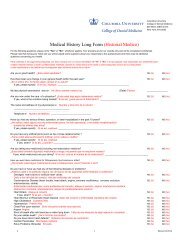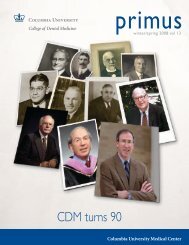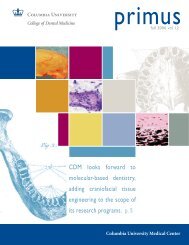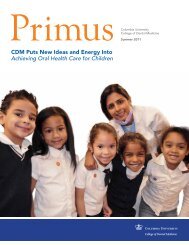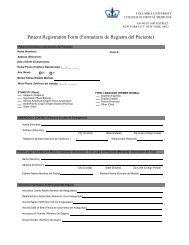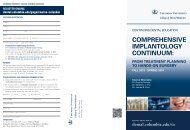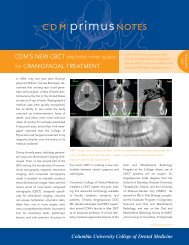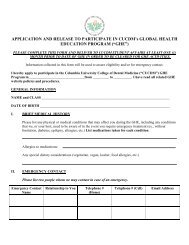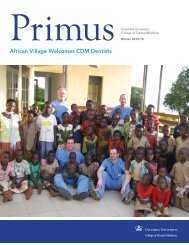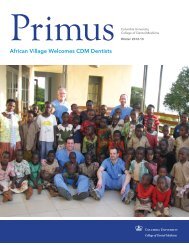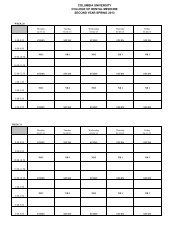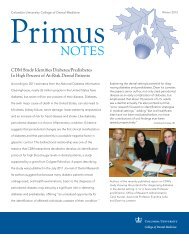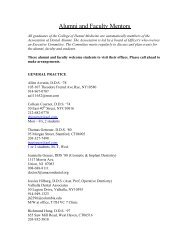Jarvie Journal - College of Dental Medicine - Columbia University
Jarvie Journal - College of Dental Medicine - Columbia University
Jarvie Journal - College of Dental Medicine - Columbia University
You also want an ePaper? Increase the reach of your titles
YUMPU automatically turns print PDFs into web optimized ePapers that Google loves.
Volume 56, Spring 2013<br />
Oral Cancer Risk Assessment: A Survey <strong>of</strong> <strong>Dental</strong> Schools<br />
Michelle Castro 2 , Deepthi Shetty 1 , Athanasios Zavras 2 *<br />
1 Postgraduate <strong>Dental</strong> Public Health Program, <strong>College</strong> <strong>of</strong> <strong>Dental</strong> <strong>Medicine</strong>, <strong>Columbia</strong> <strong>University</strong>, NY, NY<br />
2 <strong>College</strong> <strong>of</strong> <strong>Dental</strong> <strong>Medicine</strong>, <strong>Columbia</strong> <strong>University</strong>, NY, NY * Faculty Mentor<br />
Introduction: Though it account for just 2% (females)-3% (males) <strong>of</strong> all cancers, Oral Squamous Cell<br />
Carcinoma (OSCC) has one <strong>of</strong> the lowest five-year survival rates as compared with other major cancers.<br />
The odds <strong>of</strong> survival increase from a low 26% for patients with Stage 4 OSCC to 85% for patients with<br />
Stage 1 OSCC. Current risk assessment practices have not been effective in detecting OSCC in its early<br />
stages. Most early lesions are asymptomatic, contributing to why approximately 65% <strong>of</strong> patients are<br />
diagnosed at stages III or IV <strong>of</strong> the disease.<br />
Objective: Our long-term goal <strong>of</strong> this project is to introduce the science <strong>of</strong> risk assessment as a major<br />
educational requirement <strong>of</strong> predoctoral dental students and to eventually lead to increased utilization<br />
while in the <strong>Dental</strong> School environment to prepare students to more efficiently and effectively diagnose<br />
OSCC at an earlier stage.<br />
Materials and Methods: One <strong>of</strong> the major resources that we are using for this task is the knowledge <strong>of</strong><br />
the pr<strong>of</strong>essors <strong>of</strong> oral pathology and oral medicine who are currently teaching the predoctoral students.<br />
With their help, we have gone about collecting information in the form <strong>of</strong> a survey to begin to<br />
understand the opportunities for improvement in current practices. The results <strong>of</strong> this survey helped us<br />
to develop an algorithm that indicates risk assessment. We developed the first draft <strong>of</strong> a risk algorithm<br />
that is currently being pilot tested in dental clinics at <strong>Columbia</strong> <strong>University</strong>. Patients will be evaluated on<br />
a broad variety <strong>of</strong> risk factors including alcohol consumption and quantity, tobacco use and quantity,<br />
quantity <strong>of</strong> partners on whom the patient has performed oral sex, consumption <strong>of</strong> various food such as<br />
fruits, vegetables, dairy products, seafood, and meat products, and high-risk occupations. We will<br />
continue to evaluate and adapt our processes accordingly.<br />
Additionally, we included an open-answer section to our survey that encouraged faculty members to<br />
opine on the strengths and weaknesses <strong>of</strong> their curriculum as well as to discuss different obstacles that<br />
they feel are present in oral cancer assessment. This section also allows responders to further clarify<br />
previous answers, which increases their value in modifying our algorithm.<br />
Results and Conclusions: There were several areas for opportunity that were a source <strong>of</strong> focus for a<br />
large percentage <strong>of</strong> the dentists polled. While a majority felt that each dental student did a routine check<br />
for suspicious lesions as part <strong>of</strong> standard protocol, many felt that graduating students were not capable <strong>of</strong><br />
actually recognizing a malignant lesion. An even larger percentage felt that graduating students were not<br />
capable <strong>of</strong> recognizing a pre-malignant lesion. Almost half <strong>of</strong> the polled dentists felt that graduating<br />
students did not sufficiently discuss oral cancer prevention with “high-risk” patients. 50% <strong>of</strong> all polled<br />
did not believe that graduating dentists had received sufficient education in smoking cessation and<br />
47.5% felt that there was insufficient training in alcohol abuse cessation. 65% <strong>of</strong> dentists polled felt that<br />
students graduated without a proper understanding <strong>of</strong> the cost versus benefit <strong>of</strong> oral cancer screening.<br />
Discussion: It is our aim to approach improvements to pre-doctoral curricula from a scientific<br />
perspective as opposed to simply a seemingly logical one. This is an ongoing process that will require<br />
continued revision <strong>of</strong> the algorithm. Based on the continually revised results <strong>of</strong> our meta-analyses<br />
identifying an expanded list <strong>of</strong> risk factors, our ongoing interactions with oral pathology and medicine<br />
pr<strong>of</strong>essors, and continued research to better understand the barriers to effective risk assessment, we will<br />
continue to evaluate and adapt our processes accordingly.<br />
Michelle Castro was supported by a <strong>College</strong> <strong>of</strong> <strong>Dental</strong> <strong>Medicine</strong> Pre-Doctoral Summer Research<br />
Fellowship sponsored by the New York Academy <strong>of</strong> Dentistry.<br />
31



